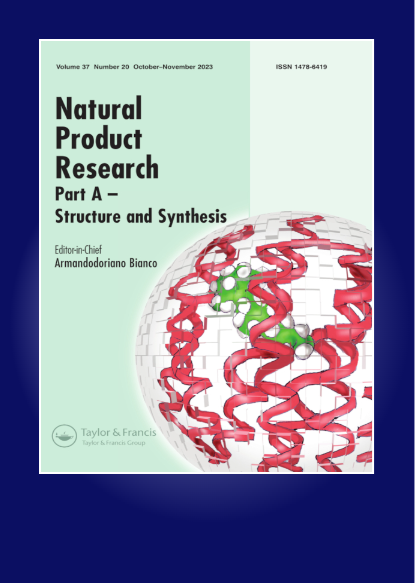A new acylated triterpene glycoside and cytotoxic constituents from Dolichandrone serrulata (Wall. ex DC.) Seem
IF 1.6
3区 化学
Q3 CHEMISTRY, APPLIED
引用次数: 0
Abstract
In this study, a new acylated triterpene glycoside, 3α-O-stearoyl-28-[2′-stearoyl-α-l-arabinopyranosyl]-olean-12-en-28-oic acid (1), was isolated from the flowers of Dolichandrone serrulata. In addition to this compound, eleven known compounds were also isolated, including a related pentacyclic triterpenoid: ursolic acid (2), two cycloartane triterpenoids: 24-methylenecycloartanol (3) and 24-methylenecycloartane-3,28-diol (4), three cyclohexylethane derivatives: (-)-rengyolone (5), (-)-cleroindicin C (6) and (-)-cleroindicin D (7), an iridoid: 6-O-trans-feruloyl catalpol (8), two phenylethanoid glycosides: salidroside (9) and verbascoside (10), and two steroids: β-sitosterol (11) and β-sitosterol-3-O-β-d-glucopyranoside (12). The chemical structures of these compounds were determined by analysing their HRMS and NMR spectroscopic data. Additionally, their cytotoxic activities against NH22, HCT116, MCF7, MDA-MB-231, and HeLa cell lines were evaluated for all the compounds. Ursolic acid exhibited moderate cytotoxic activity against all cancer cell lines tested, particularly against HN22, MDA-MB-231, MCF-7, and HCT116 cells with IC50 values of approximately 19–34 µM.
Dolichandrone serrulata (Wall. ex DC.) Seem.A new acylated triterpene glycoside and cytotoxic constituents from Dolichandrone serrulata (Wall. ex DC.) Seem.
本研究从 Dolichandrone serrulata 的花中分离出了一种新的酰化三萜苷,即 3α-O-stearoyl-28-[2'-stearoyl-α-l-arabinopyranosyl]-olean-12-en-28-oic acid(1)。除该化合物外,还分离出 11 种已知化合物,包括一种相关的五环三萜类化合物:熊果酸 (2);两种环木菠萝烷三萜类化合物:24-亚甲基环木菠萝烷醇 (3) 和 24-亚甲基环木菠萝烷-3,28-二醇 (4);三种环己基乙烷衍生物:(-)-rengyolone (5)、(-)-cleroindicin C (6) 和 (-)-cleroindicin D (7);一种铱类化合物:6-O-反式阿魏酰梓醇(8),两种苯乙醇苷:水杨苷(9)和马鞭草苷(10),以及两种类固醇:β-谷甾醇(11)和β-谷甾醇-3-O-β-d-吡喃葡萄糖苷(12)。通过分析这些化合物的 HRMS 和 NMR 光谱数据,确定了它们的化学结构。此外,还评估了所有化合物对 NH22、HCT116、MCF7、MDA-MB-231 和 HeLa 细胞系的细胞毒活性。熊果酸对所有测试的癌细胞株都表现出中等程度的细胞毒性活性,尤其是对 HN22、MDA-MB-231、MCF-7 和 HCT116 细胞,IC50 值约为 19-34 µM。
本文章由计算机程序翻译,如有差异,请以英文原文为准。
求助全文
约1分钟内获得全文
求助全文
来源期刊

Natural Product Research
化学-医药化学
CiteScore
5.10
自引率
9.10%
发文量
605
审稿时长
2.1 months
期刊介绍:
The aim of Natural Product Research is to publish important contributions in the field of natural product chemistry. The journal covers all aspects of research in the chemistry and biochemistry of naturally occurring compounds.
The communications include coverage of work on natural substances of land and sea and of plants, microbes and animals. Discussions of structure elucidation, synthesis and experimental biosynthesis of natural products as well as developments of methods in these areas are welcomed in the journal. Finally, research papers in fields on the chemistry-biology boundary, eg. fermentation chemistry, plant tissue culture investigations etc., are accepted into the journal.
Natural Product Research issues will be subtitled either ""Part A - Synthesis and Structure"" or ""Part B - Bioactive Natural Products"". for details on this , see the forthcoming articles section.
All manuscript submissions are subject to initial appraisal by the Editor, and, if found suitable for further consideration, to peer review by independent, anonymous expert referees. All peer review is single blind and submission is online via ScholarOne Manuscripts.
 求助内容:
求助内容: 应助结果提醒方式:
应助结果提醒方式:


